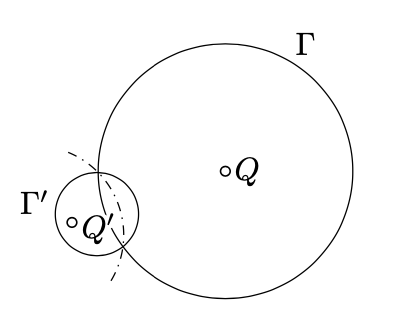10.3: Inversive plane and circlines
- Page ID
- 23642
Let \(\Omega\) be a circle with the center \(O\) and the radius r. Consider the inversion in \(\Omega\).
Recall that the inverse of \(O\) is undefined. To deal with this problem it is useful to add to the plane an extra point; it will be called the point at infinity; we will denote it as \(\infty\). We can assume that ∞ is inverse of \(O\) and the other way around.
The Euclidean plane with an added point at infinity is called the inversive plane.
We will always assume that any line and half-line contains \(\infty\).
Recall that circline, means circle or line. Therefore we may say "if a circline contains \(\infty\), then it is a line" or "a circline that does not contain \(\infty\) is a circle".
Note that according to Theorem 8.1.1, for any \(\triangle ABC\) there is a unique circline that passes thru \(A, B\), and \(C\) (if \(\triangle ABC\) is degenerate, then this is a line and if not it is a circle).
In the inversive plane, inverse of a circline is a circline.
- Proof
-
Suppose that \(O\) denotes the center of the inversion and \(r\) its radius.
Let \(\Gamma\) be a circline. Choose three distinct points \(A,B\), and \(C\) on \(\Gamma\). (If \(\triangle ABC\) is nondegenerate, then \(\Gamma\) is the circumcircle of \(\triangle ABC\); if \(\triangle ABC\) is degenerate, then \(\Gamma\) is the line passing thru \(A, B\), and \(C\).)
Let \(A', B'\), and \(C'\) denote the inverses of \(A, B\), and \(C\) respectively. Let \(\Gamma'\) be the circline that passes thru \(A', B'\), and \(C'\).
Assume \(D\) is a point of the inversive plane that is distinct from \(A, C, O\), and \(\infty\). Suppose that \(D'\) denotes the inverse of \(D\).
By Theorem 10.2.6c, \(D' \in \Gamma'\) if and only if \(D \in \Gamma\).
It remains to prove that \(O \in \Gamma \Leftrightarrow \infty \in \Gamma'\) and \(\infty \in \Gamma \Leftrightarrow O \in \Gamma'\). Since \(\Gamma\) is the inverse of \(\Gamma'\), it is sufficient to prove that
\(\infty \in \Gamma \Leftrightarrow O \in \Gamma'.\)
If \(\infty \in \Gamma\), then \(\Gamma\) is a line; or, equivalently, for any \(\varepsilon > 0\), the circline \(\Gamma\) contains a point \(P\) with \(OP > r/\varepsilon\). For the inversion \(P' \in \Gamma'\) of \(P\), we have that \(OP' = r^2/OP < r \cdot \varepsilon\). That is, the circline \(\Gamma'\) contains points arbitrarily close to \(O\). It follows that \(O \in \Gamma'\). The same way we can check the converse.
Assume that the circle \(\Gamma'\) is the inverse of the circle \(\Gamma\). Suppose that \(Q\) denotes the center of \(\Gamma\) and \(Q'\) denotes the inverse of \(Q\). Show that \(Q'\) is not the center of \(\Gamma'\).

- Hint
-
First show that for any \(r>0\) and for any real numbers \(x,y\) distinct from 0,
\(\dfrac{r^2}{(x + y)/2} = (\dfrac{r^2}{x} + \dfrac{r^2}{y})/2\)
if and only if \(x = y\).
Suppose that \(\ell\) denotes the line passing thru \(Q\), \(Q'\), and the center of the inversion \(O\). Choose an isometry \(\ell \to \mathbb{R}\) that sends \(O\) to 0; assume \(x, y \in \mathbb{R}\) are the values of \(\ell\) for the two points of intersection \(\ell \cap \Gamma\); note that \(x \ne y\). Assume \(r\) is the radius of the circle of inversion. Then the left hand side above is the coordinate of \(Q'\) and the right hand side is the coordinate of the center of \(\Gamma'\).
Assume that a circumtool is a geometric construction tool that produces a circline passing thru any three given points.
Show that with only a circumtool, it is impossible to construct the center of a given circle.
- Hint
-
A solution is given in Section 19.4.
Show that for any pair of tangent circles in the inversive plane, there is an inversion that sends them to a pair of parallel lines.
- Hint
-
Apply an inversion in a circle with the center at the only point of intersection of the circles; then use Theorem \(\PageIndex{2}\)
Consider the inversion of the inversive plane in the circle \(\Omega\) with the center \(O\). Then
(a) A line passing thru \(O\) is inverted into itself.
(b) A line not passing thru \(O\) is inverted into a circle that passes thru \(O\), and the other way around.
(c) A circle not passing thru \(O\) is inverted into a circle not passing thru \(O\).
- Proof
-
In the proof we use Theorem \(\PageIndex{1}\) without mentioning it.
(a). Note that if a line passes thru \(O\), it contains both \(\infty\) and \(O\). Therefore, its inverse also contains \(\infty\) and \(O\). In particular, the image is a line passing thru \(O\).
(b). Since any line \(\ell\) passes thru \(\infty\), its image \(\ell'\) has to contain \(O\). If the line does not contain \(O\), then \(\ell' \not\ni \infty\); that is, \(\ell'\) is not a line. Therefore, \(\ell'\) is a circle that passes thru \(O\).
(c). If the circle \(\Gamma\) does not contain \(O\), then its image \(\Gamma'\) does not contain \(\infty\). Therefore, \(\Gamma'\) is a circle. Since \(\Gamma \not\ni \infty\) we get that \(\Gamma' \ni O\). Hence the result.


